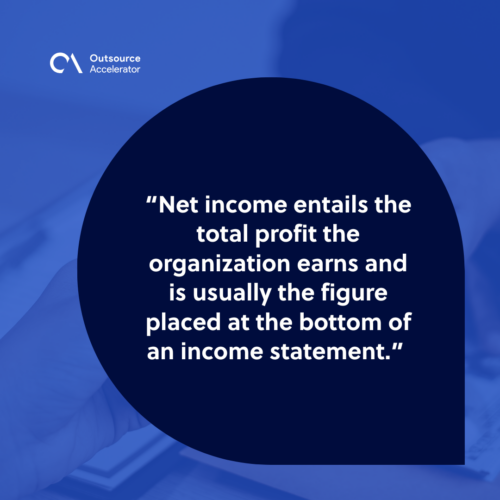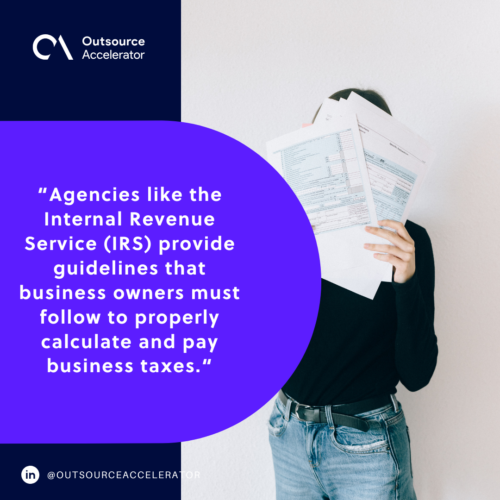How to find net income: A simple guide for your business

Familiarizing yourself with key financial and accounting terminologies is crucial in running a business.
Popularly known as the bottom line of overall profit, net income is a crucial term that aspiring entrepreneurs and business ventures must understand.
Knowing how to find net income accurately helps create a more strategic direction for a business’s financial activities, leading to better management of operational costs and taxes.
Understanding net income is also valuable, especially for small businesses, as it promotes more informed decisions that drive operational growth and long-term success.
Once an organization understands the importance and advantages of properly documenting and recording all financial transactions, creating accurate and reliable financial reports will naturally follow.
This is why hiring virtual accountants is becoming an emerging trend among small firms. Their expertise ensures that financial activities are properly monitored and recorded.
In this article, we’ll guide you through the steps to calculate the net income of your business effectively.
What is net income?
Net income entails the total profit the organization earns and is usually the figure placed at the bottom of an income statement.
It reflects the final and absolute earnings left to a firm after deducting all expenses, costs, and taxes incurred from its total revenue.
Determining a company’s net income is essential for assessing whether it has truly earned a profit and successfully delivered a return on investment (ROI).
A positive net income indicates that the organization earned more than it spent, signaling good financial health and overall business stability.
Net income also establishes a firm’s image of sustainability. It is one of the figures that most investors use to check for a possible partnership or investment in your organization.

Importance of net income in business planning
As stated, net income determines the total profit a company earns after taking all deductions for the day-to-day operating costs and other expenses.
It is a vital metric of a company’s financial status and is often considered the most accurate basis for its profitability. It reflects the actual earnings left from the business’s total revenue.
Finding net income is essential for determining whether the company truly generated a profit and achieved a return on investment (ROI).
A business’s total net income influences its ability to set realistic resource allocation plans, forecast future revenues, and explore potential expansion opportunities.
A positive net income means the organization earned more than it spent, indicating strong financial health and overall business stability.
Net income vs gross income
Net income and gross income are fundamental elements of business finance and accounting, which help monitor the movement of all financial transactions.
Although closely related, each has its specific purpose and significance, providing valuable insights into a company’s financial health.
Gross income shows a company’s total earnings from sales revenue after subtracting the direct costs of production, but before operating expenses, taxes, and other costs are deducted to calculate net income.
Understanding the key differences between gross income and net income is essential for accurately analyzing the following aspects:
- Financial Analysis: Knowing how to calculate both gross and net income enables a company to accurately measure its true earning capacity and operational effectiveness.
- Tax Compliance: Gross income serves as the basis for calculating taxes, while net income reflects the actual funds available after all obligations are met.
- Planning and Budgeting: A clear understanding of how much money remains after expenses helps businesses create more effective budgets and strategic financial plans.
5 Key components of finding net income
Finance and accounting staff analyze several key components to accurately deduct all expenses and costs from a firm’s total revenue and determine its net income.
These components consist of the following:
1. Revenue (Total sales or income)
Company revenue is the sum of all income earned from selling or delivering goods and services before taking away all deductions, such as expenses and taxes.
For example, if a business sells four laptops for $100,000, the total revenue is recorded as $100,000.
2. Cost of Goods Sold (COGS)
COGS are expenses incurred by the company to support production and deliver the daily cost of operation for its goods and services offered, such as labor and raw materials.
It covers everything directly tied to production but excludes costs like commercial rent, utilities, and marketing.
3. Operating expenses
Apart from the costs that will fall under the COGS, expenses intended to cover the daily cost of operation to sustain service delivery are considered operating expenses.
- Office rent and utilities
- Salaries and wages
- Advertising and marketing
- Supplies and insurance
- Repairs and maintenance
- Depreciation & amortization
4. Taxes
Taxes are obligations owed to government authorities and must be factored into net income calculations.
Agencies like the Internal Revenue Service (IRS) provide guidelines that business owners must follow to properly calculate and pay business taxes.

5. Other income/expenses
Other non-operating components include interest, investment income, depreciation, and gains or losses from asset sales.
Including these items in the financial report ensures a more accurate and reliable calculation of how much of the total revenue contributes to the net income.
How to find the total net income in your business
After identifying the key components needed to calculate your business’s net income, you can now apply them using the net income formula by following these simple steps:
- Calculate total revenue: First, determine the total earnings from the sale of products or services over a specific period.
- Subtract the Cost of Goods Sold (COGS): Remove all direct expenses related to production, including raw materials and direct labor.
- Subtract operating expenses: Deduct the daily operational costs needed to keep the business running, including rent, salaries (for non-production staff), utilities, and marketing expenses.
- Account for non-operating expenses: Subtract other financial costs not directly tied to operations, such as loan interest, losses from asset sales, or investment expenses.
- Deduct business taxes: Finally, subtract any applicable taxes owed to the government to arrive at your final net profit.
To help us understand more about the process of how to find net income, let us have a simple example using the formula:
(Revenue) – (Cost of Goods Sold) – (Operating Expenses) – (Taxes) – (Interest) = Net Income
If the finance and accounting staff of the firm listed the following amounts under these components:
- Revenue = $200,000
- COGS = $80,000
- Operating Expenses = $60,000
- Interest = $4,000
- Taxes = $10,000
$200,000 – $80,000 – $60,000 – $4,000 – $10,000 = $46,000 (Net Income)
The formula will give us a total net income of $46,000.00 after deducting all the key components required to find the final profit after running a business.
Common mistakes in finding net income
The formula for finding net income is not complicated, but understanding each expense and identifying which category it will fall into sometimes challenges the person in charge of the report.
When calculating net income, a single mistake can have a domino effect on other computations, leaving the overall financial statement inaccurate.
Here are some of the common mistakes in finding the net income you should know:
1. Failure to account for all business expenses
There are instances where hidden costs and expenses, such as interests, depreciation, and taxes, are not properly accounted for and reflected in the financial report.
Negligence in these areas can inflate a business’s current net income and give a misleading analysis of its financial condition.
The role of an in-house or outsourced bookkeeping staff is crucial to ensure that all transactions, including possible hidden costs, are properly identified and forecasted.
2. Confusing gross and net income
Another frequent mistake in preparing financial reports is confusing net with gross income.
Mixing these two will lead to a major misinterpretation of the company’s financial status. One good example is overestimating business profit and making poor financial decisions based on misleading numbers.
3. Inaccurate financial report
Recording and accurately filing documents regarding all financial transactions is very important in all aspects of business finance and accounting.
Every amount is needed to create a balance and an accurate financial statement. Best practices include keeping detailed records and learning to separate business and personal expenses.
Always remember that double-checking all items and figures in the report is necessary before doing the final calculations.
Empowering better financial planning decisions through net income analysis
Knowing how to find net income and conducting strategic analysis enables businesses to go beyond simply tracking cash flow — it helps assess the effectiveness of resource utilization.
Income analysis strengthens financial planning by forecasting operational challenges and trends, such as rising expenses, overall financial performance, and potential future profits.
These factors contribute to the growing demand for outsourced finance and accounting services, as accurate net income reporting plays a crucial role in financial planning and decision-making.
Net income empowers businesses to pursue strategic initiatives and future investments, supported by data-driven budgeting and forecasting.
By understanding their net income, business leaders gain valuable insights into their operational sustainability, financial efficiency, and long-term growth potential.







 Independent
Independent




